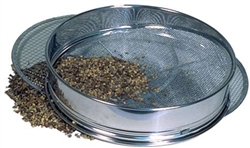Bonsai Soil: 2013 Ideas
By 'lyn Stevenson
November 10, 2013
There are as many different recipes for bonsai soil mixes as there are bonsaiists. Everyone who pots and repots eventually comes up with her/his own particular recipes.
My current favorite mix is:
I might use decomposed granite for larger trees.
I usually add some cottonseed meal and gypsum to the mix just before potting.
The basic mix used in San Diego for many years was:
November 10, 2013
There are as many different recipes for bonsai soil mixes as there are bonsaiists. Everyone who pots and repots eventually comes up with her/his own particular recipes.
My current favorite mix is:
- 50% scoria
- 20% pumice
- 5% sand (sometimes)
- 10% tiny orchid bark
- 15-20% Miracle-Gro potting soil (contains Canadian sphagnum peat moss, forest products, compost, perlite, and slow release N-P-K additives)
I might use decomposed granite for larger trees.
I usually add some cottonseed meal and gypsum to the mix just before potting.
The basic mix used in San Diego for many years was:
- 1/3 pumice
- 1/3 #12 silica
- 1/3 potting soil
 Bonsai Soil Sieve with Interchangeable Screens
Bonsai Soil Sieve with Interchangeable Screens
Remember: Ingredients should be sifted (wear a mask) and washed. Ingredients should be about the same size. Always read product labels carefully!
Excellent general reference books on soil:
Enjoy mixing your own soils!
Excellent general reference books on soil:
- Start with Soil by Grace Gershuny (Rodale Press)
- Secrets to Great Soil by Elizabeth Stell (Storey Communications)
Enjoy mixing your own soils!
Bonsai Soils / Additives
There are as many different recipes for bonsai soil mixes as there are bonsaiists. Everyone who pots and repots eventually comes up with her/his own particular recipes. Ingredients should be sifted and washed and kept the same size. The following organic and non-organic (chemical) ingredients to consider in your bonsai soil include:
- D.G.* - decomposed granite - all heavier than pumice
- D.G. Fine Mix* - i.e., "Empire Gold"
- Pumice - white or light tan volcanic rock
- Sand* - river sand/mason's sand - NOT beach sand
- Scoria* - black or red lava - much neater/lighter than D.G. in pots
- Red Lava Rock*
- Kanuma - Japanese clay
- Hyuga - Japanese pumic (Kiryu)
- Turface - (Profile) partially fired clay
- Kanoba - use with Turface for azalea mix
- Peat Moss - sifted and soaked, prefer New Zealand (Canadian)
- Oak Leaf Mold
- Dry Stall - horse bedding prodoct
- Fir/Pine Bark - composed small or shredded - not fresh
- Perlite
- Vermiculite - UGH! Skip unless doing seedlings
- Chicken Grit - crushed granite
- Pea Gravel*
- Potting Soil - Uncle Malcom's Potting Mix, Super Soil, Miracle-Gro , or other enriched nursery mix (read labels!)
- Earthworm Castings
* items usually comes in different sizes
Fertilizers and/or additives can include:
- Cottonseed Meal
- Bone Meal
- Blood Meal
- Miracle-Gro
- Charcoal (several people prefer bamboo charcoal)
- Dyna-Gro (7-9-5)
- Gypsum (soil conditioner, granular or liquid)
Soils & Fertility & The Numbers
Soil fertility requires nutrients to exist in sufficient quantities but also in balanced form and are released with WATER... either positively or negatively!
The pH scale from 1 to 14 is a measure of the acidity or alkalinity of soil. A pH of 7.0 is neutral. Acidity is indicated by a pH below 7.0 and a pH over 7.0 indicates alkalinity. The ideal is 6.3 to 6.8. Peat moss is 3.0 - 4.5.
Extreme acidity and alkalinity disrupt soil organisms and interfere with breakdown of organic matter and release of nutrients.
The pH scale from 1 to 14 is a measure of the acidity or alkalinity of soil. A pH of 7.0 is neutral. Acidity is indicated by a pH below 7.0 and a pH over 7.0 indicates alkalinity. The ideal is 6.3 to 6.8. Peat moss is 3.0 - 4.5.
Extreme acidity and alkalinity disrupt soil organisms and interfere with breakdown of organic matter and release of nutrients.
NPK are three major ingredients and stand for three macronutrients, the analysis of the soil and/or the fertilizer:
Commercial organic fertilizers can have numbers such as:
4-5-4, 1-1-1 (fish meal), 5-5-5, 8-5-5, etc.
Important micronutrients such as Iron (Fe), Manganese (Mn), Zinc (Zn), Copper (Cu), Boron (B), and Molybdenum (Mo) are essential for growth also.
Gypsum is a balancer and contains 22% calcium and 17% sulphur.
For more information, refer to the book Start with Soil by Grace Gershuny (Rodale Press).
- N Nitrogen or nitrate - High in blood meal and cottonseed meal
- P Phosphorus or phosphate - High in bone meal
- K Potassium or potash - high in wood ashes
Commercial organic fertilizers can have numbers such as:
4-5-4, 1-1-1 (fish meal), 5-5-5, 8-5-5, etc.
Important micronutrients such as Iron (Fe), Manganese (Mn), Zinc (Zn), Copper (Cu), Boron (B), and Molybdenum (Mo) are essential for growth also.
Gypsum is a balancer and contains 22% calcium and 17% sulphur.
For more information, refer to the book Start with Soil by Grace Gershuny (Rodale Press).
